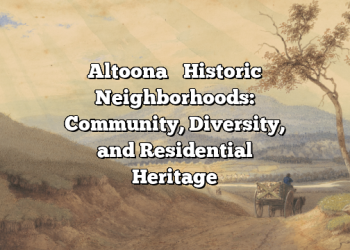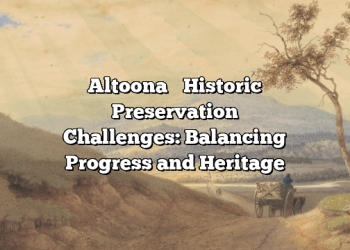Introduction to Altoona’s Historic Transportation
Welcome to the fascinating world of Altoona’s historic transportation! This city, nestled in the heart of Pennsylvania, boasts a rich and colorful transport history. Whether you’re a history buff, a transport enthusiast, or just interested in Altoona’s past, buckle up for a riveting journey through time.
The Grasp of the Iron Horse
Altoona’s transport history is deeply intertwined with the rise of the railroad industry. In fact, the city itself was born out of the Pennsylvania Railroad’s need for a base between Philadelphia and Pittsburgh. The ‘Iron City’ soon became synonymous with the mighty locomotives that powered America’s westward expansion.
The Horseshoe Curve, a marvel of engineering, is a testament to Altoona’s rail heritage. This railroad curve, built in the mid-19th century, was a crucial part of the Pennsylvania Railroad, enabling trains to cross the formidable Allegheny Mountains.
Revolution on the Streets: Enter the Streetcars
- In the late 19th century, another revolution was brewing on Altoona’s streets. The introduction of streetcars marked Altoona’s transition from a railroad town to a city with a more modern and diversified transport system.
- The Altoona and Logan Valley Electric Railway, established in 1882, provided the city’s residents with a new, convenient mode of transport. Over the years, the humble streetcar played a pivotal role in shaping Altoona’s suburban growth and development.
Bus: The Game-Changer
The 20th century heralded a significant shift in Altoona’s transportation landscape. The rise of the bus as a popular mode of public transport marked the beginning of the end for the city’s beloved streetcars. Buses, with their ability to navigate the city’s expanding road network, offered a flexibility that the fixed routes of streetcars couldn’t match.
Altoona’s Modern Transit Landscape
Fast-forward to the present, and Altoona’s transport system has evolved to meet the demands of a modern, bustling city. Today, the city’s public transit is managed by the Altoona Metropolitan Transit Authority (AMTRAN), which provides bus services across the region. Yes, the streetcars may be gone, but their legacy lives on in Altoona’s commitment to providing accessible and efficient public transport.
What’s Next for Altoona’s Transportation?
While celebrating its past, Altoona is also looking forward to the future of transportation. From exploring sustainable transport solutions to enhancing connectivity, the city is always on the move. So, stay tuned for more exciting developments in Altoona’s transport story!
Now that you’ve gotten a taste of Altoona’s rich transport history, are you ready to delve deeper? In the next sections, we will explore the birth and evolution of streetcars in Altoona, the impact of buses on the city’s transport system, and much more. So, sit back and enjoy the ride!
The Birth and Evolution of Streetcars in Altoona
Hey, have you ever wondered about the beginnings of streetcars in Altoona, a charming city nestled in the mountains of Pennsylvania? Well, get ready for an engaging throwback into the past, as we journey through the fascinating birth and evolution of streetcars in this city.
A Journey Back in Time: The Birth of Streetcars
Altoona’s streetcar story begins in the late 19th century. The Altoona and Logan Valley Electric Railway, as it was known then, was set up in 1882. The inception of streetcars in Altoona was a significant milestone, and it’s interesting to note that this was around the same time when the streetcar systems were taking root in other parts of the U.S. The streetcars here were initially horse-drawn, a common feature in the early streetcar systems. These types of streetcars, often referred to as horsecars, were the first form of public transport in the city.
The Electrification Era
However, the horsecar era didn’t last long. An exciting transformation took place in the early 1890s when the entire system was electrified! This was a major breakthrough, as it made the streetcar system faster, more efficient and capable of carrying more passengers. Altoona was now in the electric streetcar era.
- 1891: The first electric streetcar began operation.
- 1892: All horse-drawn streetcars were phased out.
- 1893: The city boasted a comprehensive network of electric streetcars serving both urban and suburban areas.
The Evolution of Altoona’s Streetcars
Demands for transportation services grew in tandem with the city’s burgeoning population and thriving economy. This necessitated the expansion and upgrading of the streetcar system. Over the years, the electric streetcars underwent several modifications, enhancing their speed, capacity, and comfort.
By the early 20th century, Altoona’s streetcar system had become a critical part of the city’s infrastructure. It not only opened up new avenues for trade and commerce but also played a pivotal role in shaping Altoona’s urban landscape.
The Decline of Streetcars
Like countless other American cities, the heyday of streetcars in Altoona was relatively short-lived. By the mid-20th century, the advent of buses signaled a new era in public transportation. This led to the gradual decline of streetcars, and by 1954, all streetcar services in Altoona were discontinued, marking an end to an era.
That’s the journey of streetcars in Altoona for you, folks! An exciting ride from the horse-drawn carriages of the 1880s to the electric streetcars of the 20th century. It’s a story of innovation, evolution, and change that continues to resonate with the city’s dynamic spirit.
The Impact of Buses on Altoona’s Transport System
Well, dear reader, if you’ve ever taken a moment to appreciate the hustle and bustle of the city of Altoona, you may have noticed one thing: buses are everywhere! With their unmistakable roar and vibrant colors, they’ve become an integral part of the transport fabric of this city. But have you ever wondered about their impact on Altoona’s transport system? Let’s take a dive into that fascinating story!
The arrival of buses in Altoona, much like in the rest of the world, marked a significant shift in the city’s transport landscape. It was a change that not only affected how people moved around but also had far-reaching implications for the city’s infrastructure.
Buses: A Revolution in Public Transport
The introduction of buses in Altoona was nothing short of a revolution. Imagine, suddenly, instead of waiting for the scheduled streetcar, you had the liberty to hop on a bus that offered more routes and flexibility. Plus, they were faster too! This was a game-changer for the public transport system, and it wasn’t long before buses became the preferred mode of transport for most locals.
Reducing Traffic and Improving Accessibility
- The introduction of buses played a significant role in reducing traffic congestion. With a higher passenger capacity than streetcars, fewer vehicles were needed on the roads.
- Moreover, buses had a profound impact on improving accessibility. Unlike streetcars that ran on fixed tracks, buses could traverse virtually any road in the city, allowing even the most remote corners of Altoona to be easily reached.
The Domino Effect on Infrastructure
One of the often-overlooked aspects of the bus revolution is its effect on Altoona’s infrastructure. The city had to adapt to accommodate these larger vehicles – wider roads, larger parking spaces, and specialized maintenance facilities. The cityscape started changing, with the advent of bus depots and terminals becoming common sights.
Economic Implications
On the economic front, the influence of buses was equally seismic. The bus industry created numerous jobs – from bus drivers and mechanics to administrative staff. Additionally, the increased mobility facilitated by buses led to economic growth as it became easier for people to commute to work or to shop in different parts of the city.
Thus, dear reader, the introduction of buses in Altoona was not just a shift in the mode of transport; it was a transformative event that altered the city’s landscape and had profound social, economic, and infrastructural impacts. So, the next time you see a bus meandering through the streets of Altoona, take a moment to appreciate the revolution on wheels that it represents!
Transition from Streetcars to Buses: A Major Shift in Altoona’s Public Transit
Turning back the pages of history, it’s hard not to appreciate the colorful tapestry that is Altoona’s transportation landscape. As if straight out of a classic movie, the transition from streetcars to buses in Altoona represents an epochal shift in its public transit system, which reshaped the city’s identity.
The Dawn of the Bus Era
By the mid-20th century, technological evolution began making its noticeable imprint on transportation. The love affair between Altoona’s residents and the melodious clinking of streetcars began to wane. A new player entered the scene – the bus. Buses offered a fresh outlook – improved flexibility, better fuel efficiency, and the capability to service a wider area as compared to the streetcars.
While the streetcars had their charm, people started recognizing the practicality and efficiency offered by the buses. They were no longer confined to the fixed routes of the streetcars and could reach their destinations more directly. The era of buses had dawned in Altoona, marking a significant chapter in its transportation history.
Adapting to Change
Just like any significant change, this transition was not without its challenges. Adapting to the bus system required alterations in infrastructure, policy planning, and public mindset. However, the city authorities rose to the occasion, demonstrating remarkable resilience and foresight. They introduced new bus routes, refurbished the roads, and ran public awareness programs to help citizens adapt to this change.
- Infrastructure: The city had to reconfigure roads, build bus stops, and modify traffic rules to accommodate the new mode of transport.
- Policy Planning: With the introduction of buses, transportation policies underwent an overhaul. From fare structuring to route planning, everything was recalibrated in line with the changing dynamics.
- Public Mindset: The most crucial aspect of this transformation was winning public acceptance. The city conducted several campaigns to familiarize residents with the benefits of bus transit and help them transition smoothly.
The Impact
The transition from streetcars to buses brought a wind of change in Altoona. Buses enabled greater geographical reach and flexibility, thereby fostering connectivity and enhancing the city’s overall economic growth.
But the impact was not just practical – it was also emotional. For many, the buses represented progress, a step towards modernity. The adoption of buses was not just about embracing a new mode of transport; it was about the city and its residents moving forward together.
In Retrospect
Looking back, the transition from streetcars to buses solidified Altoona’s reputation as a city that is adaptive and forward-thinking. It is a testament to Altoona’s resilience and a symbol of the city’s commitment to evolving with the times. Today, as we navigate through the city’s well-connected bus routes, it’s hard not to marvel at this significant transition that shaped Altoona’s public transit landscape.
Modern Transit in Altoona: Current Trends and Developments
Let’s take a joyride through the present-day scene of transportation in Altoona. You might wonder, “What’s all the fuss about? It’s just buses and cars, right?” Well, sit tight because there’s a lot more to it than you might think!
The Current State of Transit in Altoona
Public transit in Altoona has come a long way from the days of streetcars. Today, the Altoona Metro Transit (AMTRAN) is the heart and soul of the city’s transportation system, connecting communities and people from all walks of life. It’s not just about getting from point A to point B; it’s about ensuring everyone can access their jobs, schools, healthcare, and more with ease.
Buses: The Backbone of Altoona’s Transit
- AMTRAN’s fleet of buses offers a network of routes that span the city. These buses are not just reliable; they’re also eco-friendly! AMTRAN has been steadily integrating hybrid buses into its fleet, reducing emissions and contributing to a greener Altoona.
- There’s also a special emphasis on accessibility in AMTRAN’s services. Buses are equipped with lifts and ramps, ensuring that individuals with mobility challenges can also travel with ease.
Roaring Rideshare: Altoona’s Embrace of Modern Mobility
But it’s not all about traditional public transit! Altoona has also embraced the rise of rideshare services like Uber and Lyft. These services provide a flexible, convenient alternative for those preferring private transport or traveling during off-peak hours.
Active Transportation: Biking and Walking
And let’s not forget the simplest and healthiest form of transport: our own two feet! Altoona has been progressively enhancing its infrastructure to support walking and biking, promoting a more active lifestyle among its residents. The city’s expanding network of bicycle lanes and pedestrian-friendly paths is a testament to this ongoing commitment.
The Rise of Electric Vehicles
Lastly, Altoona is also catching the electric vehicle (EV) wave. With increasing numbers of EV charging stations popping up, driving electric in Altoona is becoming more and more feasible. This is a win not only for EV owners but also for the environment!
So you see, there’s a lot happening on the transportation front in Altoona, and it’s safe to say the city is well on its way to a future that’s not just efficient and connected, but also sustainable and inclusive. And that, my friends, is what modern transit is all about!
The Role of Altoona’s Transportation in Shaping its Economic and Social Landscape
Have you ever stopped to think about the profound influence transportation has on a city’s economic and social structure? Let’s take a drive down memory lane and explore the pivotal role that Altoona’s transportation system has played in shaping its economic and social landscape.
Influence on Economy
Just think of the streetcar era! Streetcars, more than just a means of getting from point A to B, played an integral role in stimulating Altoona’s economic development. Remember how the availability of streetcars facilitated the movement of goods and services, as well as the labor force? It fostered commerce, boosted local businesses and created job opportunities, acting as an economic engine for the city.
Impact on Social Structure
It’s fascinating how transportation also significantly shaped Altoona’s social fabric. The advent of buses, for instance, introduced a more flexible and accessible mode of public transit. It allowed for greater social inclusion, as it catered to residents in even the most remote areas, breaking barriers and connecting communities.
Moreover, the evolution of Altoona’s transport system also influenced the layout of the city and lifestyle of its inhabitants. It determined where people lived, worked, and how they interacted with their surroundings.
- Residential Areas: The accessibility and reliability of public transport often influence where people choose to live. With the expansion of Altoona’s transit system, residents could live farther from the city center without being isolated.
- Workplaces: Businesses often set up shop in areas with good transport links. This not only facilitates commuting for employees but also ensures easy access for customers.
- Lifestyle: A well-connected city offers its residents a higher standard of living. It makes shopping, recreation, and socializing easier and more enjoyable.
Whether it’s the clang of streetcars or the hum of buses, every era of Altoona’s transport evolution has left an indelible mark on its economic and social tapestry, shaping its unique identity.
Remember, transportation is not just about moving people and goods – it’s also about shaping cities and societies. As Altoona continues to evolve, it will be intriguing to see how future transformations in transportation further mould its economic and social contours!
Future Prospects and Innovations in Altoona’s Transportation System
As we speed into the future, Altoona’s transportation system is gearing up for some fascinating changes. Let’s have a chat about the upcoming trends and advancements that could reshape the way you commute around this beautiful city.
The Rise of Smart Public Transportation
Imagine hopping on a bus that’s wirelessly connected to a vast network of transportation information. Sounds like sci-fi, right? But, it’s closer to reality than you might think. Altoona is exploring the potential of smart public transportation, where buses, traffic signals, and even roads communicate to optimize routes, reduce congestion, and improve passenger safety.
Green is the New Gold
With climate change marching up the global agenda, cities worldwide are looking at cleaner, greener public transit options. Altoona is no exception. The city is actively investigating the feasibility of electric buses, which can significantly reduce carbon emissions and make our air a lot healthier.
- Autonomous Vehicles: Self-driving cars and buses might still feel like a distant dream, but many cities are already testing these technologies. Could Altoona be next? It’s a possibility worth considering.
- Micro Mobility: With the rising popularity of e-scooters and bike-sharing programs, micro-mobility could play a big role in Altoona’s transportation future. It’s a fun, eco-friendly way to travel short distances.
Enhancing Mobility for All
Everyone deserves to get where they’re going easily and efficiently, right? That’s why Altoona is focusing on making its transportation system more accessible and inclusive. Initiatives include improved infrastructure for people with disabilities, increased elderly-friendly transportation options, and better connectivity in underserved neighborhoods. It’s all about ensuring that everyone can make the most out of Altoona’s wonderful transit system.
Public Involvement in Transit Planning
Good news – the future of Altoona’s transportation isn’t just shaped by tech whizzes and city officials. As residents, you have a say too! Community involvement in transit planning is expected to grow, with more opportunities for public feedback and participation. After all, who knows the city’s commuting needs better than its people?
So, are you excited about the future of transportation in Altoona? It’s clear that there’s a lot to look forward to. And while change can be daunting, remember: every innovation, every upgrade is aimed at making life in Altoona even better. So sit back, relax, and enjoy the ride into the future!










